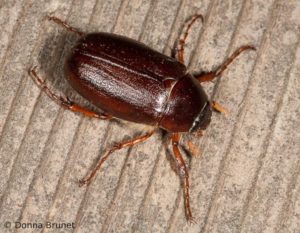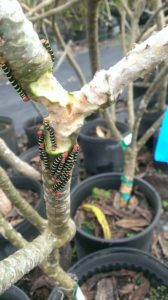Snails and slugs
– move by gliding along on a muscular “foot.” This muscle constantly secretes mucus, which later dries to form the silvery “slime trail” that signals the presence of either pest. Slugs and snails are hermaphrodites, so all have the potential to lay eggs. Adult brown garden snails lay about 80 spherical, pearly white eggs at a time into a hole in the topsoil. They may lay eggs up to six times a year. It takes about 2 years for snails to mature. Slugs reach maturity after about 3 to 6 months, depending on species, and lay clear oval to round eggs in batches of 3 to 40 under leaves, in soil cracks, and in other protected areas.
Snails and slugs are most active at night and on cloudy or foggy days. On sunny days they seek hiding places out of the heat and bright light; often the only clues to their presence are their silvery trails and plant damage. In mild-winter areas such as southern coastal locations, young snails and slugs can be active throughout the year.
During cold weather, snails and slugs hibernate in the topsoil. During hot, dry periods or when it is cold, snails seal themselves off with a parchmentlike membrane and often attach themselves to tree trunks, fences, or walls.
Snails and slugs feed on a variety of living plants as well as on decaying plant matter. On plants they chew irregular holes with smooth edges in leaves and flowers and can clip succulent plant parts. They can also chew fruit and young plant bark. Because they prefer succulent foliage or flowers, they are primarily pests of seedlings and herbaceous plants, but they are also serious pests of ripening fruits, such as strawberries, artichokes, and tomatoes, that are close to the ground.
Eliminate and Control
A good snail and slug management program relies on a combination of methods. The first step is to eliminate, to the extent possible, all places where snails or slugs can hide during the day. Boards, stones, debris, weedy areas around tree trunks, leafy branches growing close to the ground, and dense ground covers such as ivy are ideal sheltering spots. There will be shelters that are not possible to eliminate—e.g., low ledges on fences, the undersides of wooden decks, and water meter boxes. Make a regular practice of trapping and removing snails and slugs in these areas. Also, locate vegetable gardens or susceptible plants as far away as possible from these areas. Reducing hiding places allows fewer snails and slugs to survive. The survivors congregate in the remaining shelters, where they can more easily be located and removed. Switching from sprinkler irrigation to drip irrigation will reduce humidity and moist surfaces, making the habitat less favorable for these pests. Choose snail-proof plants for areas where snails and slugs are dense. Copper barriers can be useful for protecting especially susceptible plants. Though baits can be part of a management program for snails and slugs, by themselves they don’t provide adequate control in gardens that contain plenty of shelter, food, and moisture.
Handpicking can be very effective if done thoroughly on a regular basis. Snails and slugs can be trapped under boards or flower pots positioned throughout the garden and landscape. Several types of barriers will keep snails and slugs out of planting beds. The easiest to maintain are those made with copper flashing and screen. Copper barriers are effective because it is thought that the copper reacts with the slime that the snail or slug secretes, causing a flow of electricity. Vertical copper screens can be erected around planting beds. The screen should be 6 inches tall and buried several inches below the soil to prevent slugs from crawling through the soil beneath the barrier. Snails and slugs have many natural enemies, including ground beetles, pathogens, snakes, toads, turtles, and birds, but most are rarely effective enough to provide satisfactory control in the garden.
Snail and slug baits can be effective when used properly in conjunction with a cultural program incorporating the other methods discussed above. However, baits alone will not effectively control snails or slugs. Several types of snail and slug bait products are available. Baits containing the active ingredient metaldehyde are most common. Metaldehyde baits are particularly poisonous to dogs and cats, and the pelleted form is especially attractive to dogs. Metaldehyde snail baits should not be used where children and pets cannot be kept away from them. Some metaldehyde products are formulated with carbaryl, partly to increase the spectrum of pests controlled to include soil and debris-dwelling insects, spiders, and sowbugs. However, carbaryl is toxic to soil-inhabiting beneficials like ground beetles and earthworms and should be avoided if snail and slug management is all that is required. Metaldehyde baits containing 4% metaldehyde are significantly more effective than those products containing only 2% metaldehyde; however, they are also more toxic to dogs and wildlife. Most currently available 4% products are formulated for use in enclosed bait stations to minimize their hazard.
Avoid getting metaldehyde bait on plants, especially vegetables. Baits containing only metaldehyde are most reliable when temperatures are warm or following a rain when snails and slugs are active. Metaldehyde does not kill snails and slugs directly unless they eat a substantial amount; rather, it stimulates their mucous-producing cells to overproduce mucous in an attempt to detoxify the bait. The cells eventually fail and the snail dies. When it is sunny or hot, they die from desiccation. If baiting is followed by cool and wet weather, they may recover if they ingest a sublethal dose. Do not water heavily for at least 3 or 4 days after bait placement; watering will reduce effectiveness and snails may recover from metaldehyde poisoning if high moisture conditions occur. Most metaldehyde baits break down rapidly when exposed to sunlight; however, some paste or bullet formulations (such as Deadline) hold up somewhat longer under conditions of sunlight and moisture.
A recently registered snail and slug bait, iron phosphate (available under many trade names including Sluggo and Escar-Go), has the advantage of being safe for use around domestic animals, children, birds, fish, and other wildlife and is a good choice for a garden IPM program. Ingestion of the iron phosphate bait, even in small amounts, will cause snails and slugs to cease feeding, although it may take several days for the snails to die. Iron phosphate bait can be scattered on lawns or on the soil around any vegetables, ornamentals, or fruit trees to be protected. Iron phosphate baits may be more effective against snails than slugs.
 DESCRIPTION
DESCRIPTION